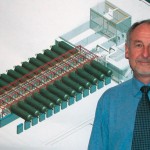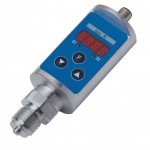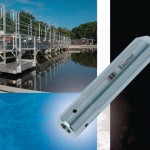Having built more than 10,000 plants all over the world serving one billion people, Degrémont has proved itself without any doubt to be a global leader in the field of water treatment. The company develops and builds a wide range of facilities such as drinking water production installations, desalination plants, waste water treatment and sewage sludge processing plants for local commu-nities and industrial enterprises. To ensure the efficient operation of its plants, Degrémont relies on the know-how and expertise of dedicated partners and suppliers. Digital devices such as TED50 and ED752 manufactured by Baumer are used for pressure measurement and level detection.
Mikael Leth Jensen
Degrémont is a subsidiary of the French water and waste disposal group Suez Environnement. Since its foundation in Paris (France) back in 1939, the company has acquired extensive experience in water processing and treatment technologies. It is recognised all over the world as a reference in relation to the design, construction and delivery of turnkey installations. “Our main fields of expertise are waste water treatment, seawater desalination (reverse osmosis) and drinking water treatment. And of course, we also have know-how in the area of sewage sludge processing”, explains Patrick Descamps, an engineer and instrumentation expert based at the company headquarters in Rueil-Malmaison (France). The Degrémont teams are capable of handl-ing all aspects of large-scale projects: operation, process optimisation, technical assistance and maintenance of the installations. Technical experts check, validate and approve the project and plant. “Our solutions must therefore use reliable, state-of-the-art measuring instruments that are easy to parameterise and easy to adjust to the process requirements”, Descamps adds.
When it comes to process instrumentation, analogue technology remains satisfactory for simple measuring or monitoring applications. For some years, Degrémont has been using Baumer’s mechanical instruments to measure pressure and temperature. However, whenever there is a need to transmit measurement data or ensure a high and repeatable level of accuracy, it is crucial to switch to digital technology. “As soon as we consider it necessary, we replace our mechanical pressure gauges and pres-sure and temperature switches with electronic devices, which is why we turned to Baumer. Since Baumer’s mechanical instruments have been giving us full satisfaction for many years, it was natural for us to continue our cooperation with a reliable partner, capable of providing technical so-lutions in line with our requirements”, Descamps explains. “For instance, one single electronic pressure switch is now enough to perform the operations previously carried out by three separate devices, because the pressure switch has a built-in digital pressure gauge and pres-sure transmitter.”
On-site programming of pressure switches
The TED50 product from Baumer Process Instrumentation is a digital pressure switch featuring two galvanically isolated thresh-old outputs with a switching output of 400 mA at 60 V(DC). It measures vacuum and pressure in pressure ranges from 0/1 to 0/400 bar for absolute pressure and from -1/0 to 0/400 bar for gauge pressure. The output signal is achieved through the 3-wire current loop. “Galvanic isolation avoids disturbances and protects the circuits, because the pressure switch power supply is electrically isolated from the signal outputs”, asserts Gérard Demeulenaere, Product Marketing Manager at Baumer.
“Thanks to the integrated software, the switch points can be adjusted in accordance with the needs of the application to open or close the two dry contacts at preset pres-sure values”, Descamps continues. In addition, on-site programming of the instrument is child’s play with the three keys on the front panel for the triggering values for both thresholds or for the hysteresis of each threshold, active status of the threshold, etc. The switch point adjustment levels range from 2 % to 98 % full-scale and the typical response time of the outputs is 20 ms. “The high levels of performance of the TED50 – ±0.5 % full-scale accuracy with ±0.2 % full-scale repeatability and a maximum thermal drift of ±0.015 % per °C – are particularly suited to water treatment installations”, Demeulenaere stresses.
Degrémont also chose the TED50 for its high resistance to vibrations of 1.5 mm (10 to 55 Hz) and 20 g (55 Hz to 2 kHz) according to EN 60068-2-6. “This insensitivity to vibration, which is much higher than in the case of mechanical instruments, is an important criterion since our installations comprise pipeworks and other positive-displacement pumps”, Patrick Descamps confirms. Finally, Baumer’s digital pres-sure switch was selected because it is available with several pressure connections, and in particular a flush diaphragm connection, which is ideal for raw sewage applications. The microprocessor-based TED50 comes in a robust stainless steel housing. “In the range of TED pressure switches, we also offer models with PNP transistor outputs, a Modbus 0 to 10 V output signal, Atex approval or an adjustable head over 300 °”, Demeulenaere reveals.
Pressure measurement devices can be found at every stage of processing in Degrémont’s plants. The TED50 pressure switches are used in the sewage sludge processing facilities at the Limay and Le Havre sites as well as in the drinking water treatment installations in Saint-Cloud and Apremont. “In reverse osmosis plants, which desalinate seawater to turn it into drinking water, the pressure switches are mounted on diaphragm separators made of Monel or Hastelloy C materials that are capable of withstanding sea salt corrosion; this applies, for instance, to the Al Dur (Bahrain), Barka (Oman) and Barcelona (Spain) sites”, adds Descamps. To date, close to 300 TED50s have been delivered and installed by Degrémont worldwide.
The TED50 is also used in Degrémont’s Ultrafor solution. In this biological process for the treatment of urban waste water (UWW), the conventional clarification method is replaced with ultrafiltration. By combining biological treatment and diaphragm filtration technologies, Ultrafor makes it possible to discharge high-quality water back into sensitive natural environments or to reuse processed water. This so-lution is already in place in a number of cities in France and abroad – Qatar and the Canary Islands for example.
Hydrostatic level measurement using a pressure transmitter
The reliability of depth measurement devices is vital in water-related applications. Baumer’s ED752 pressure transmitter is based on the principle of hydrostatic level measurement. Used as a submersible device, it allows high accuracy for depth measurements, including in raw sewage or waste water. Furthermore, the measurements are not affected by foaming, the presence of surface contaminants or condensation in the tank, all of which constitute a problem for ultrasonic sensors. Descamps comments as follows: “This pressure transmitter makes up for the shortcomings of ultrasonic sensors; for instance, when a fluid drops four metres into a pit seven metres deep, the foam forming in the process can rise to a height of one metre.” In addition, ultrasonic sensors are also more difficult to install because they must be placed away from walls. This creates a dead zone under the sensor, which may lead to erroneous readings.
The ED752 pressure transmitter contains a piezo-resistive silicon sensor, which is isolated from the process by a stainless steel diaphragm and a filling liquid. The sensor is bonded onto a very stable glass base, which is attached to a stainless steel structure. This assembly guarantees excellent thermal insulation. The electronic components are located within the hermetically sealed transmitter housing, which provides the ED752 with excellent resistance to shock and vibration. Built entirely from stainless steel, the transmitter is also available in Hastelloy C, allowing it to resist the most aggressive fluids, such as seawater. Its protection class is IP 68.
Measurement of differential pressure variations
Baumer has developed a reliable solution to assess the level of clogging in the filters of water basins. Based on two submersible ED752 pressure transmitters and a DX display, this system measures differential pressure variations caused by the obstruction of the filters. The two ED752 transmitters measure pressure values upstream and downstream of the filter. A DX display receives the signals from the transmitters and calculates the differential pressure, which it then converts into an analogue 4 to 20 mA output signal. “We are interested in this solution to simplify the maintenance of our reverse osmosis installations, where the water is pumped out of the sea and contains various residues”, Descamps explains.
Online-Info www.cpp-net.com/2310451
Share:











